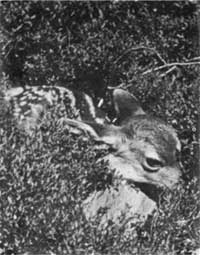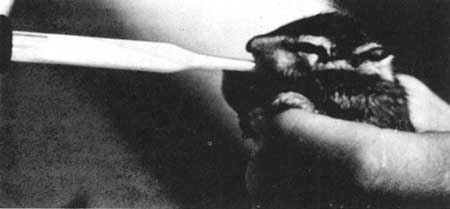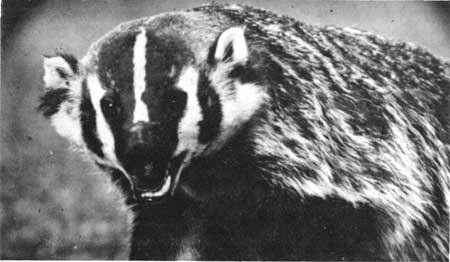Once in a Lifetime
On June 29, 1954, the day dawned bright and clear. Early in the morning, Assistant Park Naturalist Richard Brown and I were driving down the highway toward South Entrance when suddenly, rounding one of the sharp curves, we came upon a group of parked cars. We proceeded to a turn-out and then returned to the scene on foot.
“What has happened?” brought an immediate chorus, “There is a baby in there among the trees.” “A what?” We were then able to find out from one of the people present that there was a baby deer in the area. The first group of people had seen a Columbian black-tailed doe and two fawns. When they stopped to take a closer look, the doe and one of the fawns jumped off into the woods, while the other fawn remained near the edge of the highway.
 Fawn in Huckleberry Patch From Kodachrome by Richard M. Brown |
We watched from a distance as the cameras clicked and the movie cameras droned on. After all the people had left the area, we took a closer look at the fawn. There it lay, directly in front of us, probably no more than a day or two old. It was nestled in a clump of huckleberry, its head resting on an old log. On either side of the clump of huckleberry were young mountain hemlock trees, about ten or twelve feet high.
Waiting for the sun to highlight the fawn, hoping it would not move, and trying to appear nonchalant as the cars passed by truly taxed our patience. Finally the stage was set, and Richard Brown began to take pictures of the fawn from a distance of fifty feet. With the camera showing only a few pictures remaining, Dick proceeded to move closer to the fawn, finally approaching within a few feet. During this entire time, the fawn appeared as motionless as a statue. After the roll of film was used up, I decided to see how motionless it would remain. Moving my arms outward, I gradually approached the fawn. Still no movement. Slowly I moved my hand outward as if to pet the animal. Not an eyelash fluttered. The only movement was the slight heaving of its body as it breathed. We were able to approach within a foot of the fawn.
Finally we went on our way, allowing the fawn to return to its mother. On our way back, later that same morning, we stopped at this place again, but there was no trace of the fawn.
After recounting the incident to my family that evening, we decided to return to the spot that night. Approaching cautiously, we saw a doe about 1,000 yards from the original point. Would we be able to see the doe with its two fawns again? Slowly creeping up to the area near the huckleberry mat, we peered breathlessly through the brush into the place where we had originally seen the fawn. We gazed upon an ordinary clump of huckleberries; no fawn was to be seen that night or any succeeding night. Truly we had been lucky in seeing the “once in a lifetime” view of a very young fawn that morning.
The Nutcracker and the Baby Chipmunk
On Saturday afternoon, July 31, 1954, at 2:55 p.m. I was on duty at the Information Building — normal, routine duty. In came a sobbing, small girl, carrying a little blue toy wagon. In the cart was a tiny bundle, a baby chipmunk.
“One of those great big birds with the long bill picked him up, tried to fly away with him and then dropped him. He’s going to die!” Strong emotions were very evident.
Further questioning, with answers backed up by her father, placed the chipnapping at the Lodge end of the Rim Campground. The “villain” with the long bill was a Clark nutcracker, Nucifraga columbiana (Wilson).
The little fellow lay flat in my hand, eyes closed, trembling violently for such a tiny chap. Cupping him in both hands for a few minutes and gently stroking his head and back seemed to help overcome some of the terror. A gentle examination showed no evidence of any injury — just scared and no mama around.
Finally he opened his eyes, looked around, then poked his head up under my shirt cuff. This wasn’t quite safe enough, so he crawled up inside the right sleeve of my blouse to the bend in the elbow. There he stayed until we closed the Information Building shortly after five o’clock. During this period, whenever writing was required, it perhaps appeared as though I had a broken right arm. Appearances can be deceiving.
Still up my coat sleeve, he rode down to Government Headquarters where I had to remove my coat and ease him out of his newly-found refuge.
Assistant Park Naturalist Richard Brown suggested eye dropper feeding with milk. We warmed a small bottle of milk under hot running water in the Naturalist Laboratory. As Ranger Welles held the little chap, nose just visible, I gave him the milk by letting it run down Ralph’s thumb onto his nose. He rapidly caught on and finally took the dropper into his mouth. Soon he fell sound asleep. He’d had a rough day!
Ranger and Florence Welles took the youngster to their trailer for two days. There he was fed by eyedropper at short intervals. After the first twenty-four hours he eagerly took hold of the dropper with both front paws while he was drinking his milk. It was decided that the little fellow is an Allen’s chipmunk, Eutamias townsendi senex (Allen).

From Kodachrome by Welles & Welles
An attempt was made to find the original home and mother of the chipmunk, with no success. On the following Tuesday, Mrs. William Loftis wife of the Park Engineer, took over the upbringing of the little “orphan.” A cage of wood and wire was built. A rumpled up diaper was placed in the bottom as a nest or sanctuary. One week after he was brought into the Information Building he had learned to lap his milk. He was “off the bottle!” At the time of this writing he is eating banana nut bread and taking peanuts when offered, but hiding them under his cage cloth rather than eating them. His small ears, which had been lying back on his head, are now standing up.
As if to verify this nutcracker-chipmunk story, on August 4th, on the road in front of Government Headquarters, another Clark nutcracker was interrupted as he attempted to pick up a baby Mazama pocket gopher, Thomomys monticola mazama Merriam.
The problem now is that our little chipmunk friend has become adapted to a human environment. How will he make out when we let him go back to his own natural habitat? Often baby animals are picked up and brought to rangers in many of the National Parks by kind-hearted people who believe them to be lost or abandoned. Usually it is to the best interest of the young animal to be left where he belongs — in his own wild state where his mother will raise him and care for him.
Mr. and Mrs. Loftis have recently released this little chap, and he seems to be making out quite well on his own. Currently he is living in the wall of the Loftis’ residence, entering by a very small outside hole. We hope he passes the winter successfully. Perhaps we may be able to find out what becomes of our little “orphan chipmunk” in a later issue of Nature Notes.
A Certain Badger
On one of my husband’s days off, he and I were returning from Klamath Falls. When we approached the Chiloquin turn-off we could see, lying motionless in the road, an animal my husband instantly recognized as a badger. We stopped as quickly as we could, and stepped out of the car.
It was then that we had the privilege of seeing what we had always heard and read about the badger. He slowly stood up in the manner of a groggy fighter who had been knocked out but still had the drive to go on. He was breathing heavily and bleeding a little from the nose. While we were wondering about the extent of his injuries he slowly made his way off the highway and into the grass.
We photographed and watched him for some time, thinking that if his wounds should be fatal we could still take him along. But gradually his breathing became quieter. He growled very meaningfully when my husband came nearer to him than he wanted. We noticed that there seemed to be both squirrels and gophers living near where he was resting quite naturally now. So we left him. Three days later Naturalist Richard M. Brown examined the area thoroughly to see whether or not he had survived, and we can assume that he did, for no trace of him could be found.

From Kodachrome by Welles & Welles

